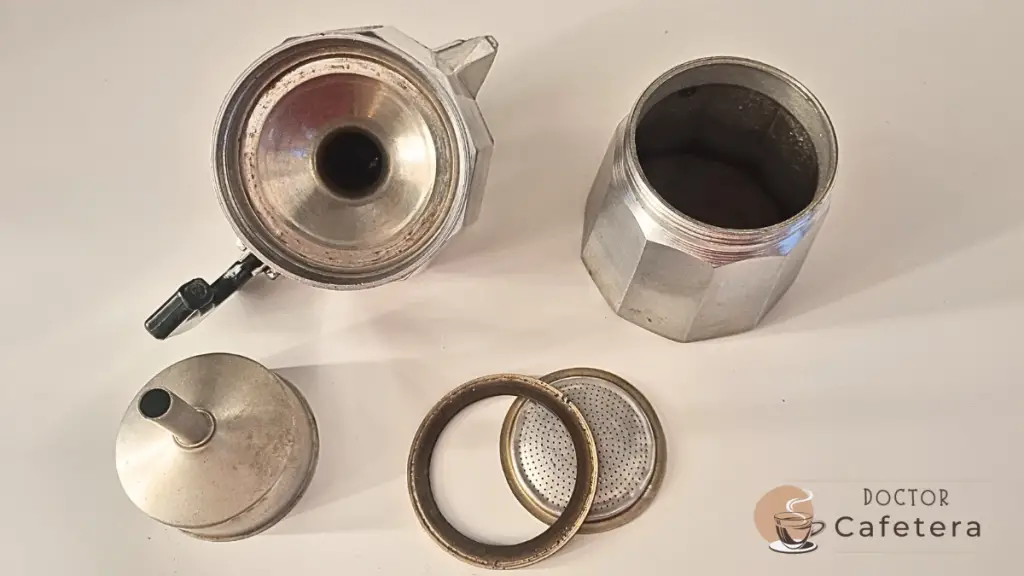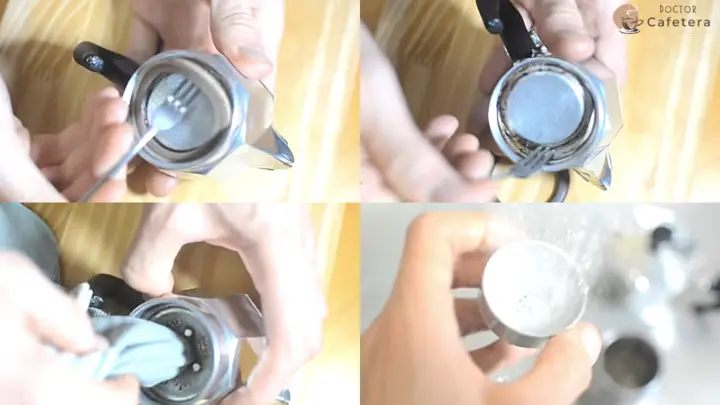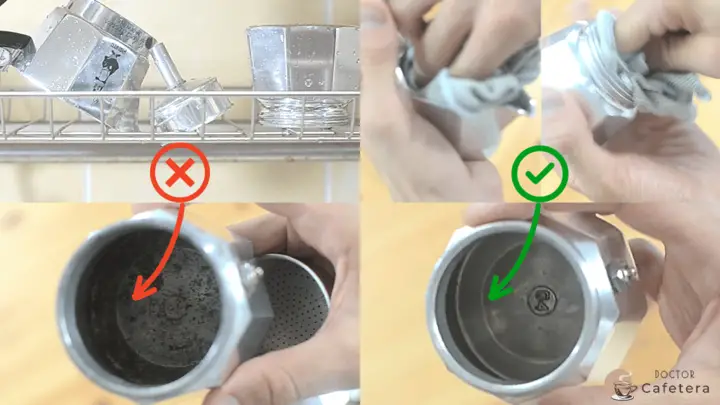Moka pots are very popular in many countries, but doubts and false beliefs often surround their cleaning. This part of its maintenance is essential for a good performance and taste of coffee, so I have prepared this article that addresses the CORRECT and detailed cleaning of Moka pots.
- Completely disassemble the coffee maker, including the rubber gasket and the flat filter.
- Wash all parts with soap and water to remove coffee residue and oils (be careful with aluminum Moka pots).
- Thoroughly dry each part to avoid bacteria and mineral build-up.
- Once dry, reassemble, making sure not to over-tighten the parts.
- Store the coffee maker in a dry place.
How to clean (for the first time) a brand-new Moka pot
When you start using a new Moka pot, certain initial steps are crucial for its future optimal performance. Contrary to what some may think, these steps are essential.
The longevity and performance of your Moka depend largely on how you perform the first cleaning.
- As a first step, it is essential to wash the coffee maker both inside and out thoroughly. Avoid abrasive detergents or cleaning agents, as they could damage your new Moka. Instead, use only water.
- The second step consists of running the Moka without a coffee. That is, fill the water reservoir with water up to the level of the safety valve, but do not add ground coffee to the funnel. The water will heat up and thoroughly clean the coffee maker as it passes through the filter and the column. This step ensures that your coffee maker is free of any initial residue from manufacturing.
- A third step involves brewing several pots of coffee and disposing of them. Although this may seem like an unnecessary waste of coffee, it is an investment in the future performance of the Moka pot.
Steps to wash a Moka Pot after use
Remember that Italian coffee makers have three main parts: the upper chamber, the filter for ground coffee (funnel), and the water reservoir. In addition, there are two very important auxiliary components: the flat filter and the rubber gasket.
To ensure a complete and proper cleaning of the coffee maker, it is essential to disassemble it completely, which implies removing both the rubber gasket and the flat filter after each use:
It is very important to wash not only the exterior but also the interior of the Moka pot since it is there where dirt can accumulate, which can end up affecting the quality of the coffee. Once you have completely disassembled the coffee maker, follow these steps for a complete cleaning:
- Cleaning the upper chamber. This is where the brewed coffee ends up and is more exposed to dirt accumulation. Clean this area very well with soap and water.
- Cleaning the back of the upper chamber. Behind the flat filter, we find the back of the upper chamber where the coffee is extracted. Use the handle of a fork wrapped in a soft cloth to clean the center, then wash very well with soap and water to remove the oils that accumulate there.
- Cleaning the rubber gasket. A rubber gasket at the bottom of the chamber holds the flat filter and seals all components. First, run a soft cloth over it to sweep out the deposits and remove the gasket with the help of a blunt object such as a fork. Then, wash this component thoroughly to remove all accumulated debris.
- Cleaning the flat filter. After removing the gasket, you can easily remove the flat filter, which also accumulates a lot of coffee and oil residues (if this filter is dirty, it can radically change the taste of the coffee). Remove all the dirt by washing the filter well with soap and water.
- Clean the lower chamber (water reservoir). Also, wash the water reservoir, inside and out, using soap and water.
- Finally, clean the coffee funnel. To conclude with all the components, the funnel where the ground coffee is deposited should be cleaned. Also, use soap and water and rinse very well.
- Dry all the parts very well with a cloth. Once the coffee maker is dry, return everything as it was, and do not over-tighten the thread to store it.
⚠️ Once all the components have been cleaned, dry each part well using a soft cloth. This step is very important and should not be skipped, since water by nature contains bacteria and minerals that can ruin the coffee maker in the long run.
Never let your Moka pot air dry after washing it. Before storing or using it again, always dry it without leaving any traces of water in it.
Although the above seven steps are necessary for a correct cleaning, it may not be necessary to do them every day, but I recommend doing it at least once a week. As for drying the coffee pot, always do it.
Should soap be used to wash a Moka pot?
This question is frequently asked, and the important thing to remember is that coffee contains oils that remain in the coffee maker every time you brew a drink. These oils are greasy and cannot be easily removed with water alone.
➡️ That being said, I believe it is necessary to use soap to ensure your Moka can be completely clean without the risk of any residues accumulating.
Is it safe to wash Moka pot in the dishwasher?
Cleaning your Moka pot in the dishwasher may seem convenient, but it is not recommended to avoid permanent stains on its finish.
- If your coffee maker is made of aluminum, I do not recommend putting it in the dishwasher under any circumstances. The high temperatures accompanied by using an abrasive detergent can damage it, causing unwanted stains.
- As for stainless steel Moka pots, while washing them in the dishwasher is theoretically possible, I still recommend manual cleaning to prevent possible stains on the interior and exterior.
The issue with dishwasher cleaning is that these appliances use water at very high temperatures and very abrasive degreasing products. While these conditions are great for pans and pots, they are terrible for Italian coffee makers.
Is there any other method to clean a Moka pot that doesn’t use soap?
I know many skeptics regarding washing the Moka using soap and prefer to do it only with water. Thinking about this, I wanted to test two different cleaning methods without using soap and see if they could be equally effective.
The first involved washing the coffee maker with a neutral and light salt, while the second used only hot water. After testing both cleaning techniques, I concluded that both can provide satisfactory results.
It’s also worth noting that, after a consistent period of washing my old Moka pot with neutral salt and meticulous drying each time, I was pleasantly surprised to find that it now looks more immaculate and shiny, as if it were a completely new coffee maker.
I leave it to your judgment and preferences for your desired cleaning method. However, I recommend never forgetting to dry all components of the Moka pot very well to prevent water from ruining them.
Is it advisable to use vinegar to clean a Moka pot?
Vinegar can be an effective tool for removing mineral residues and coffee remnants that accumulate over time, affecting the taste of your brews. However, it’s important to use it judiciously following some guidelines. Here are its pros and cons:
Pros of using vinegar in the cleaning of your Moka pot:
- Removes mineral residues: The acidity of vinegar can effectively dissolve mineral deposits that accumulate in the coffee maker over time.
- Combats stale taste: By eliminating coffee residues and accumulated oils, vinegar can restore the original taste of the coffee.
- Cheap and easy to find: Vinegar is an affordable product common in most households.
Cons of using vinegar in cleaning:
- Odor and residual taste: If you don’t properly adjust the amount of vinegar during cleaning, it may leave a residue of odor and taste in the coffee maker. If this happens, perform a thorough rinse to prevent it from influencing the taste of your coffee.
- Possible stains on the exterior: If you overuse vinegar or use it too concentrated, it may leave stains on the exterior of your Italian coffee maker.
How to clean a burnt Italian coffee maker
At some point in our lives, we have all burnt at least one Moka pot. However, cleaning this type of stain is more complicated than it seems, as you have to consider the material of the Moka and how burnt your beloved coffee maker is.
As I believe this issue is important and different from regular cleaning, I have created an exclusive article explaining different tested and effective methods: “How to clean burnt Moka pot.”


